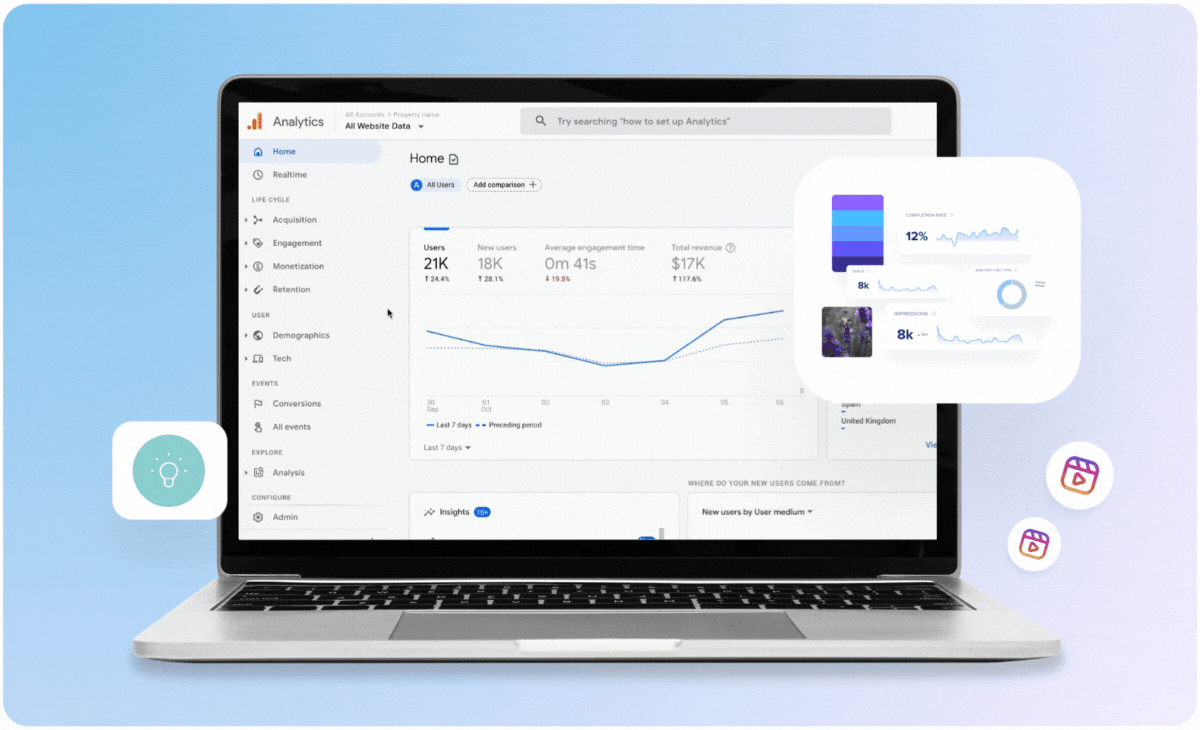
Are you tired of posting on social media without knowing if your efforts are paying off? Do you need help measuring the success of your campaigns and proving their value to company stakeholders?
Look no further! In this ultimate guide, we’ll dive into how to track social media metrics and calculate ROI effectively.
We’ve covered you, from defining key performance indicators (KPIs) to analyzing data. Get ready to take your social media strategy to the next level!
Introduction to Social Media Metrics
Social media metrics are the data and statistics that measure the performance of your social media marketing campaigns. This data can be used to assess the reach, engagement, and effectiveness of your social media marketing and ultimately calculate your return on investment (ROI).
There are a variety of social media metrics that you can track, but some of the most important ones include:
Reach The number of people who have seen your content.
Engagement: The number of people interacting with your content (liked, shared, commented, etc.).
Click-through rate (CTR): The percentage of people who have clicked on a link in your content.
Conversion rate: The percentage of people who have taken a desired action after seeing your content (e.g., subscribed to your blog, bought a product, etc.).
Cost per click (CPC): The amount you spend on advertising divided by the number of clicks you receive.
Cost per lead: The amount you spend on advertising divided by the number of leads you generate.
To calculate ROI for your social media marketing campaigns, you must track these metrics over time and compare them to your goals and objectives. By doing so, you will be able to see which campaign strategies are working and which ones need to be improved.
Types of Social Media Metrics
There are many different types of social media metrics that businesses can track to measure the success of their social media campaigns and calculate their ROI. Some of the most common types of social media metrics include:
-Number of followers: This metric measures the number of people following your business on social media.
-Number of likes: This metric measures the number of people who have liked your business’s social media page or posts.
-Number of shares: This metric measures the number of people who have shared your business’ social media content with their followers.
-Number of comments: This metric measures the number of people who have commented on your business’s social media posts.
Benefits of Tracking Social Media Metrics
When it comes to social media, metrics and ROI go hand-in-hand. After all, you can’t measure the success of your social media efforts without tracking the right metrics. And you can’t calculate ROI without first understanding which metrics matter.
But before we dive into which social media metrics you should be tracking, let’s first discuss the benefits of doing so:
1. Helps You Measure Progress Towards Goals
2. Enables You to Set Benchmarks
3. Allows You to Determine What’s Working (and What’s Not) 4. It gives You Insights Into Your Target Audience
5. Helps You Make Smarter, Data-Driven Decisions
6. Facilitates Better Reporting and Accountability
7. ultimately Leads to improved ROI
Best Practices for Measuring ROI on Social Media
There are several ways to measure ROI on social media, and the best approach will vary depending on your specific goals and objectives. However, some general best practices can be followed to ensure that you are getting the most accurate and actionable data possible.
1. Define your goals and objectives upfront. Before measuring anything, defining what you want to achieve with your social media activity is essential. This will help you choose the right metrics to track and make interpreting your results more accessible.
2. Track both engagement and reach metrics. Engagement metrics such as likes, comments, and shares give you an idea of how engaged your audience is with your content. Reach metrics such as impressions and views give you an idea of how many people see your content. Both types of data are essential in understanding the success of your social media activity.
3. Use multiple data sources. There are several different tools that you can use to track social media metrics. It is essential to use various data sources to get a complete picture of your performance.
4. Analyze your results regularly. Measuring ROI is not a one-time task – it should be something that you do periodically to adjust your strategy as needed. Reviewing your results regularly will help you fine-tune your approach and ensure you get the most out of your social media activity.
5. Set realistic benchmarks and goals. Setting absolute standards and goals will help you measure your progress over time and ensure that you are getting the desired results. It is important to remember that success with social media does not happen overnight, so be patient and give yourself time to achieve your desired outcomes.
How to Calculate ROI on Social Media
To calculate ROI on social media, businesses need to track various metrics. The most important metric to track is engagement, measured by the number of likes, comments, and shares a post receives. Other important metrics to track include:
- Reach (the number of people who see a bar).
- Impressions (the number of times a post is seen).
- Clicks (the number of times someone clicks on a link in a post).
- To calculate ROI, businesses must first set goals for their social media campaigns. Once goals are set, companies can track the relevant metrics and compare them to their destinations.
- If a business sees that their posts are receiving a high engagement but not reaching its goal number of impressions, it may consider investing in paid advertising. Paid advertising can boost Go and ensure more people see the business’s posts.
Calculating ROI can be complex, but businesses need to do it to measure the success of their social media campaigns. By tracking the right metrics and setting goals, companies can make informed decisions about improving their social media ROI.
Tools for Measuring Social Media Metrics and ROI
There are several different tools that you can use to measure social media metrics and ROI. Here are just a few of the most popular options:
1. Hootsuite Insights: Hootsuite’s Insights platform allows you to track various social media metrics, including engagement, reach, and impressions. You can also use the platform to calculate ROI for your social media campaigns.
2. Sprout Social: Sprout’s suite of social media tools includes a powerful analytics platform that allows you to track key social media metrics, including engagement, reach, and conversions. You can also use Sprout to calculate ROI for your social media campaigns.
3. Social bakers: Social bakers’ analytics platform provides detailed insights into your social media performance, including engagement rates, reach, and impressions. You can also use Social bakers to calculate ROI for your social media campaigns.
4. Measured: Simply Measure’s suite of social media measurement tools includes an ROI calculator that tracks the return on investment for your social media campaigns.
5. Buffer Analyze: Buffer’s Analyze tool tracks various social media metrics, including engagement, reach, clicks, and shares. You can also use Buffer Analyze to calculate ROI for your social media campaigns.
Conclusion
Social media metrics and ROI are essential to measure the success of a business’s social media marketing strategy. With this guide, you should better understand how to track these critical metrics and calculate your return on investment for your social media efforts.
By utilizing the techniques outlined in this article, you will be able to identify areas for improvement within your marketing strategy and make meaningful changes that can help improve the effectiveness and overall success of your online efforts.

